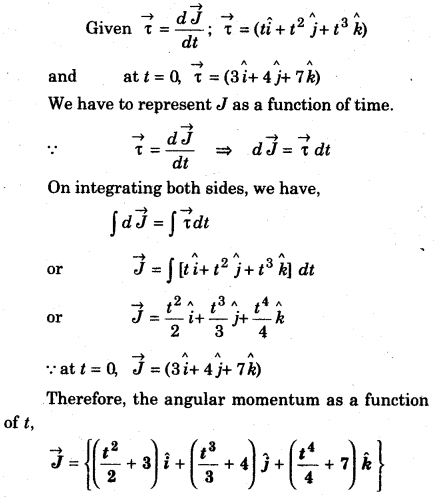Rajasthan Board RBSE Class 11 Physics Chapter 2 Basic Mathematical Concepts
RBSE Class 11 Physics Chapter 2 Textbook Exercises with Solutions
RBSE Class 11 Physics Chapter 2 Very Short Answer Type Questions
Question 1.
How many types of vectors are there?
Answer:
Vectors are of two types :
- Polar vectors
- Axial vectors
Question 2.
What are equal vectors?
Answer:
The vectors which have equal magnitude and same direction.
Question 3.
What is a unit vector?
Answer:
The vector having unit magnitude is known as unit vector.
Question 4.
What are the unit vectors corresponding to X, Y and Z – axes respectively?
Answer:
\(\hat{i}\), \(\hat{j}\) and \(\hat{k}\) are the unit vectors corresponding
to X, Y and Z axes respectively.
Question 5.
What is a zero vector?
Answer:
The vector which have zero magnitude and indicate the direction at particular point.
Question 6.
In how many types does the vectors be resolved?
Answer:
The vectors can be resolved in following two types.
- In two dimensions
- In three dimensions.
Question 7.
Can the magnitude of the resultant vector of two vectors be less than that of any of the two vectors?
Answer:
Yes, if the angle between the two vectors is greater than 90°.
Question 8.
Classify the scalar and vector quantities of the following : Force, torque, surface tension, momentum and temperature.
Answer:
Scalar : Surface tension, Temperature
Vector : Force, Torque, Momentum.
Question 9.
Can we add a scalar to a vector quantity?
Answer:
No. because scalar has only magnitude but vector has magnitude and direction both.
Question 10.
If one of the component of a vector quantity is zero but another component is not zero. Then, can the vector quantity be zero?
Answer:
No.
Question 11.
What is the magnitude of \(\vec{A} \cdot \vec{A}\)?
Answer:
\(\left|\vec{A}^{2}\right| \text { or } A^{2}\)
Question 12.
Is the vector product obey the commutative law?
Answer:
No.
Question 13.
What is the direction of the resultant vector obtained from the vector product of two vectors?
Answer:
In a direction perpendicular to the plane containing both the vectors and decided by right hand screw rule.
Question 14.
What is the vector product of two parallel vectors?
Answer:
Zero.
RBSE Class 11 Physics Chapter 2 Short Answer Type Questions
Question 1.
Differentiate between scalar quantities and vector quantities.
Answer:
Scalar Quantities
The physical quantities, which have magnitude but no direction are called scalars, accompanied by a unit.
Mass, length, distance covered, time, density, work, temperature, charge, specific heat, energy, power, speed, length etc. are few examples of scalars,
A scalar quantity can be completely described by a number; representing its magnitude. A scalar may be positive or negative. They can be added, subtracted, multiplied and divided according to the simple rules of Algebra.
Vector Quantities
The Physical quantities which have both magnitude and direction are called vectors.
Displacement, velocity, acceleration, force, momentum, electric field, impulse, gravitational field etc. are few exmaples of vector quantities.
It may be pointed out that the vectors can not be added, subtracted, multiplied or divided as one may do in case of scalars. It is because, in addition to magnitude, vectors have direction also. Vectors are added, subtracted and multiplied according to the rules of Vector Algebra. The division of a vector by another vector is not a valid operation in Vector Algebra.
Question 2.
Write the law of triangle of vector addition.
Answer:
Triangle Law of Vector Addition
It states that, “If two vectors acting on a body are represented both in magnitude and direction by two sides of a triangle taken out in a same order then the resultant is represented by the third side of the triangle taken in the opposite order in magnitude and direction.”
This simply means that, if you have two vectors that represents the two sides of the triangle then the third side of that triangle will represent their resultant.
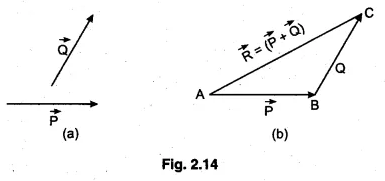
Figure 2.14 (a) shows the two vectors \(\vec{P}\) and \(\vec{Q}\). To find out their resultant (sum) by using the triangle law of vector addition, draw the vector \(\overrightarrow{A B}=\vec{P}\). Now move the vector \(\vec{Q}\) parallel to itself, such that its tail coincides with the tip of \(\vec{P}\) vector. Mark the tip of vector \(\vec{Q}\) as C [figure 2.14 (b)]. Thus the vector \(\vec{P}\) and \(\vec{Q}\) have been represented by the two sides \(\overrightarrow{A B}\) and \(\overrightarrow{B C}\) or a triangle taken is the same order.
Therefore according to the law of vector addition, the vector \(\overrightarrow{A C}=\vec{R}\) (say) drawn from the tail of the vector \(\vec{P}\) to the tip of the vector \(\vec{Q}\) is the third side of the triangle taken in the opposite order and hence it
represents the sum or the resultant of the vectors \(\vec{P}\) and \(\vec{Q}\).
Thus, \(\vec{P}+\vec{Q}=\vec{R}\)
Question 3.
What is the law of parallelogram of vector addition?
Answer:
Law of parallelogram of vector addition : According to this law, “When two vectors are represented by two adjacent arms of a parallelogram in magnitude and direction both, then the resultant of these vectors will be represented by that diagonal of the parallelogram in magnitude and direction both, which passes through the point of intersection of adjacent arms.”
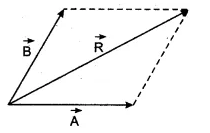
In following diagram \(\vec{R}\) is the resultant of \(\vec{A}\) and \(\vec{B}\).
Here \(\vec{R}=(\vec{A}+\vec{B})\)
Question 4.
Explain the resolution of vectors in two dimensions.
Answer:
Resolution of a vector in two Dimensions
The resolution of a vector into two mutually perpendicular vectors is called the rectangular resolution of vector in a plane or two dimensions.
Consider that a vector \(\overrightarrow{O P}=\vec{A}\) has to be resolved into two component vector along the direction of two mutually perpendicular directions of X-axis and Y-axis. Let \(\hat{i}\) and \(\hat{j}\) be the unit vectors along X-axis and Y-axis respectively figure 2.19.
From point P, drop PM and PN perpendicular to X-axis and Y-axis respectively. From the parallelogram law of vector addition, it follows that
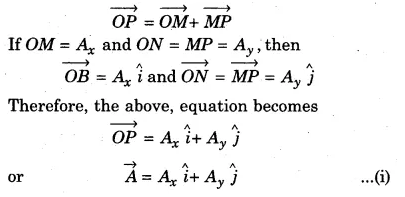
The equation (i) describes vector, \(\vec{A}\) into the component vector Ax \(\hat{i}\) and Ay \(\hat{i}\). In practice Ax \(\hat{i}\) and Ay \(\hat{j}\) are called respectively x-component and y-component of vectors \(\vec{A}\). Further Ax and Ay are called magnitude of the two component vectors.
If A is the magnitude of the vector \(\vec{A}\) and θ is its inclination with X-axis, then from the right angled triangle OMP,
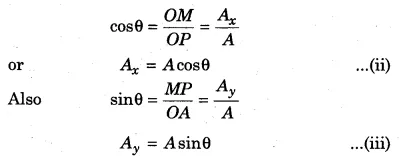
Adding the squares of Ax and Ay, we get
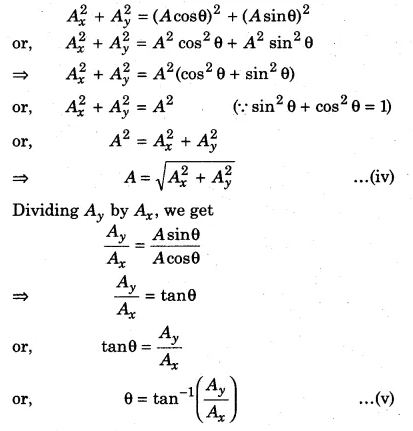
Question 5.
Explain the scalar product of two vectors.
Answer:
Dot Product or Scalar Product of Two Vectors
If the two vectors are inclined at the angle θ then the dot product of two vectors is defined as the. product of their magnitude and cosine of angle between them.
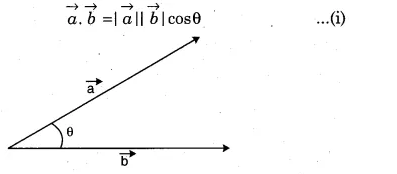
Where :
\(|\vec{a}|\) is the magnitude (length) of vector \(\vec{a}\)
\(|\vec{b}|\) is the magnitude (length) of vector \(\vec{b}\)
θ is the angle between \(\vec{a}\) and \(\vec{b}\)
So, we multiply the length of \(\vec{a}\) times the length of \(\vec{b}\), then multiply by the cosine of angle between \(\vec{a}\) and \(\vec{b}\). Since \(|\vec{a}|,|\vec{b}|\) and cosθ are scalars, so the dot product of \(\vec{a}\) and \(\vec{b}\) is a scalar quantity.
That is why dot product of two vectors is also called scalar product. Each vector, \(\vec{a}\) and \(\vec{b}\) has a direction, but their scalar product does not have a direction.
Why cos(θ)?
To multiply two vectors it makes sense to multiply their length together but only when they point in the same direction.
So we make one, “point in the same direction” as the other by multiplying by cosθ.
Scalar product of two vectors in term of their components :
\(\because \qquad \vec{a} \cdot \vec{b}=|\vec{a} \| \vec{b}| \cos \theta\)
= abcosθ
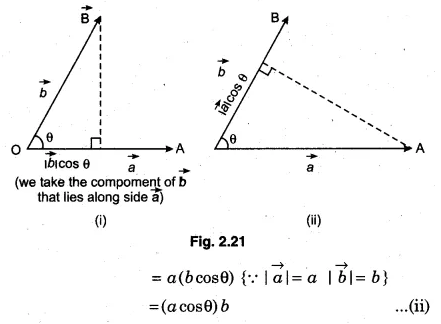
Therefore, \(\vec{a} \cdot \vec{b}\) = a(bcosθ) is the product of magnitude of \(\vec{a}\) and magnitude of component of \(\vec{b}\) along \(\vec{a}\) fig. 2.2.1 (i).
Alternating \(\vec{a} \cdot \vec{b}\) = b(acosθ) is the product of magnitude of \(\vec{b}\) and the magnitude of component of \(\vec{a}\) along, \(\vec{b}\). Thus,
“Dot product of two vectors is also defined as the product of the magnitude of one vector and the magnitude of the component of other vector in the direction of first vector.”
Question 6.
Explain the right hand screw rule for the vector product of two vectors.
Answer:
Right Hand Screw Rule : The right hand screw rule can be used when a direction must be determined, based upon rotational direction or vice-versa.
The axis of the screw is placed as shown in the figure. 2.23 (ii). When the screw is moved by a small angle in the direction from \(\vec{A}\) to\(\vec{B}\), then the direction in which the screw moves forward gives the direction of the resultant vector.
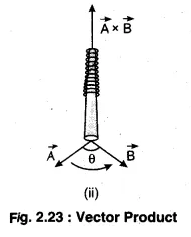
RBSE Class 11 Physics Chapter 2 Long Answer Type Questions
Question 1.
Explain the application of Differential calculus in Physics.
Answer:
Applications of Differential Calculus in Physics
There are many physical quantities that depend on other quantities. For example distance defends upon time, velocity depends upon distance and time, the pressure of a gas depends upon volume and temperature, etc.
Let us assume that the displacement \(\vec{r}\) is function of time t, i.e.,
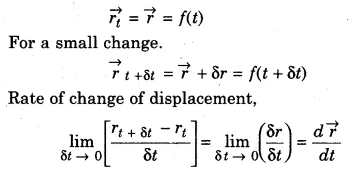
This quantity is the velocity of the object. So, the derivative of \(\vec{r}\) w.r.t. t is the velocity.
\(\vec{v}=\frac{d \vec{r}}{d t}=\frac{d}{d t}(\vec{r})\)
Similarly, the velocity \(\vec{v}\) depends upon time t. So, the rate of change of velocity is the acceleration :
Instantaneous acceleration,
\(\vec{a}=\frac{d \vec{v}}{d t}=\frac{d}{d t}\left(\frac{d \vec{r}}{d t}\right)=\frac{d^{2} r}{d t^{2}}\)
\(\frac{d^{2} r}{d t^{2}}\) is the second derivative of displacement vector \(\vec{r}\) w.r.t time (t).
Another example : Work done (W) by a force is a function of t and power P is the rate of change of work done.
∴ P = \(\frac{d W}{d t}\)
or, P = \(\frac{d E}{d t}\) (E = Energy)
The number of sctive atoms (N) present in radioactive substance is a function of time and the rate of decay A is
A = \(-\frac{d N}{d t}\)
Question 2.
Write the law of parallelogram of vector addition. Draw the labelled diagram to explain it. Obtain the formula for the resultant vectors \(\vec{R}\).
Answer:
Parallelogram law of Vector Addition
The parallelogram law is a slightly more explanation of the triangular law.
It states that if “the two vectors are considered to be the adjacent sides of a parallelogram, then, the resultant of the two vectors is given by the vector which is a diagonal passing through the point of contact of the two vectors.”
Let us find out the resultant of the two vectors \(\vec{P}\) and \(\vec{Q}\) as shown in figure 2.15 (a). To find out the resultant, draw the vector \(\overrightarrow{A B}=\vec{P}\). Now move the vector \(\vec{Q}\) parallel to itself so that its tail coincides with the tail of vector \(\vec{P}\). If we mark its tip as D, then the vector \(\overrightarrow{A D}\) represents the vector \(\vec{Q}\). Complete the parallelogram ABCD as shown in the figure 2.15 (b))].
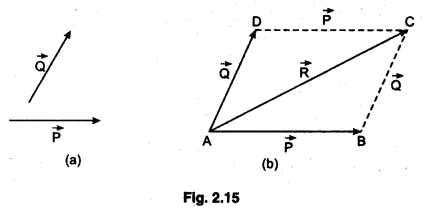
Thus, the vector \(\vec{P}\) and \(\vec{Q}\) have been represented by the two adjacent sides \(\overrightarrow{A B}\) and \(\overrightarrow{A D}\) respectively of a parallelogram. Therefore, according to the parallelogram law of vector addition, the vector \(\overrightarrow{A C}\) = \(\vec{R}\) (say), which represents the diagonal of the parallelogram passing through the point A, represents the sum or the resultant of the vector \(\vec{P}\) and \(\vec{Q}\)
Thus \(\vec{P}+\vec{Q}=\vec{R}\)
Note : According to the parallelogram law of addition of vectors \(\overrightarrow{A B}+\overrightarrow{A D}=\overrightarrow{A C}\)
Since, in a parallelogram, the opposite sides are equal and parallel, they must represent equal vectors
∴ \(\overrightarrow{A D}=\overrightarrow{B C}\)
In the above equation, setting \(\overrightarrow{A D}=\overrightarrow{B C}\), we have
\(\overrightarrow{A B}+\overrightarrow{B C}=\overrightarrow{A C}\)
It is the triangle law of vector addition. Hence triangle law of vector addition follows from the parallelogram law of vector addition.
Question 3.
Explain the resolution of vectors in three dimensions. Draw the diagram to explain it properly.
Answer:
Resolution of a vector in Three Dimensions
Consider that the vector \(\overrightarrow{O P}=\vec{A}\) represents a vector in space. In order to express it in the form of three mutually perpendicular components, construct a rectangular parallel OTBCDEP with three edges along the three co-ordinate axes OX, OY and OZ. Let \(\hat{i}, \hat{j}\) and \(\hat{k}\) be the unit vectors along OX,OY and OZ respectively as shown in the fig. 2.20.
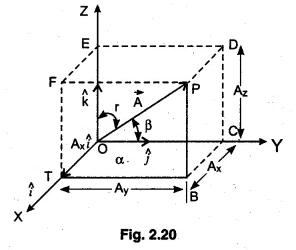
Then according to the polygon law of addition of vectors, we have
\(\overrightarrow{O P}=\overrightarrow{O T}+\overrightarrow{T B}+\overrightarrow{B P}\) ……….. (i)
If the three sides of the rectangular figure respectively are OT = Ax, OC = Ay and OE = Az
Then, \(\overrightarrow{O T}=A_{x} \hat{i}\), \(\overrightarrow{O C}=A_{y} \hat{j}\) and \(\overrightarrow{O E}=A_{z} \hat{k}\)
Since, \(\overrightarrow{T B}=\overrightarrow{O C}=A_{y} \hat{j}\) and
\(\overrightarrow{B P}=\overrightarrow{O E}=\overrightarrow{C D}=A_{z} \hat{k}\),
Then the equation (i) becomes
\(\vec{A}=A_{x} \hat{i}+A_{y} \hat{j}+A_{z} \hat{k}\) ……………… (ii)
The equation (ii) expresses the vector \(\vec{A}\) oriented in space (three dimensions) in terms of its three rectangular components \(A_{x} \hat{i}\), \(A_{y} \hat{j}\) and \(A_{z} \hat{k}\).
Magnitude of \(\vec{A}\) :
In triangle OBP
OP2 = OB2 + BP2
In triangle OCB
OB2 = OC2 + CB2 = OC2 + OT2
∴ OP2 = OC2 + OT2 + BP2
A2 = \(A_{y}^{2}+A_{x}^{2}+A_{z}^{2}\)
or A = \(\sqrt{A_{x}^{2}+A_{y}^{2}+A_{z}^{2}}\) …………… (iii)
Thus the magnitude of a vector is equal to the square root of the sum of the squares of the magnitude of its rectangular components.
Question 4.
Explain the vector product with the help of a diagram.
Answer:
Vector Product or Cross Product of Two Vectors
If we get a vector quantity on multiplying two vector quantities, then this product is called a vector product or a cross product. Vector product is expressed by putting a cross (X) mark between the two vectors.
The vector product of two vectors \(\vec{A}\) and \(\vec{B}\) is another vector \(\vec{C}\), whose magnitude is equal to the product of the magnitudes of the two vectors and sine of the angle between them.
Let the magnitudes of the vectors \(\vec{A}\) and \(\vec{B}\) be A and B, and the angle between them be θ. Then, the vector product is given as:
\(\vec { A } \times \vec { B } =\left| \vec { A } \right| \vec { B } |\sin \theta \hat { n } \)
or \(\vec { A } \times \vec { B } =AB\sin \theta \hat { n } \) …………….. (i)
Here, \(\hat{n}\) is the unit vector is the direction of the magnitude of the resultant vector. its direction is perpendicular to the plane of vector \(\vec{A}\) and \(\vec{B}\)
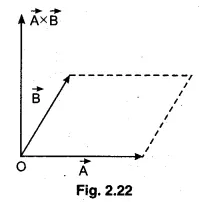
RBSE Class 11 Physics Chapter 2 Numerical Questions
Question 1.
The vertical component of a force is 200 N. The force makes an angle of 30° with the horizontal. Calculate the force.
Solution:
Given, θ = 30°
FV = 200N
F = ?
∵ FV = F sinθ
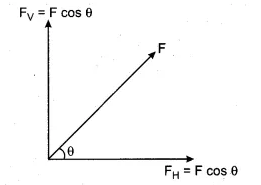
∴ F = \(\frac{F_{V}}{\sin \theta}=\frac{200 \mathrm{N}}{\sin 30}=\frac{200 \mathrm{N}}{1 / 2}\)
or F = 200 × 2N
or F = 400 N
Question 2.
Determine the magnitude of the vector \(\vec{A}=3 \hat{i}+4 \hat{j}\).
Solution:
Magnitude of the vector \(\vec{A}=x \hat{i}+y \hat{j}+z \hat{k}\) is,
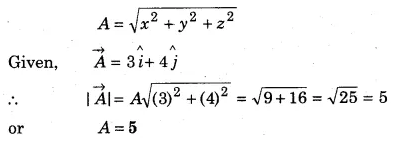
Question 3.
Determine the value of the unit vector of vector \(\vec{A}=(4 \hat{i}+3 \hat{j}-5 \hat{k})\).
Solution:
If \(\hat{n}\) be the unit vector in the direction of vector \(\vec{A}\), then
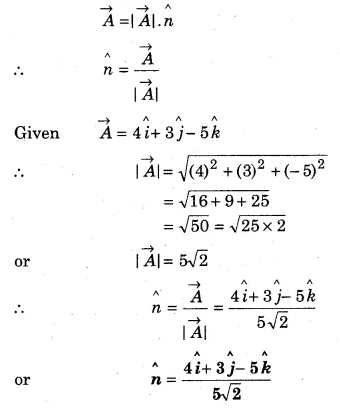
Question 4.
Find out the value of \(\frac{d}{d x}\left(x^{7}\right)\)
Solution:
Formula used,
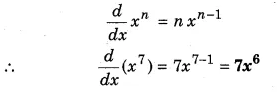
Question 5.
Find out the value of \(\frac{d}{d x}\left(x^{-3}\right)\)
Solution:
Formula used,

Question 6.
Find out the value of \(\int x^{4} d x\).
Solution:
Formula used,

Question 7.
Find out the value of \(\int x^{-5} d x\)
Solution:
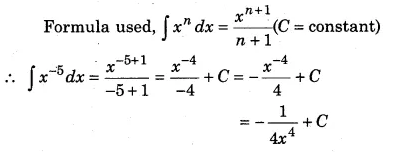
Question 8.
What is the characteristic of the number 83256?
Solution:
Characteristic of the logarithm of a number = no of digits. – 1
Characteristic of no. 83256 = 5 – 1 = 4
Or
The given number = 83256 = 8.3256 × 104
∴ The characteristic of the given number = 4
Question 9.
What is the characteristic of the number 0.00356.
Solution:
Given number = 0.00356
How to find out the characteristic of a number.
A common logarithm is simply on exponent of base 10. Characteristic is the power of 10 when a number is written in scientific notation i. e., putting decimal point after one digit.
For example if x = 2.567 × 10n.
Then characteristic of x will be n.
Now the given number = 0.00356 = 3.56 × 10-3
Hence, the characteristic of given number = \(\overline{3}\)
Question 10.
Find out the value of log (8621).
Solution:
The given number,
x = 8621 = 8.621 × 103
∴ The characteristic of x = 3
From log table the mantisa of x = 0.9356
Therefore logx = log8621 = 3.9356
Question 11.
Two forces, F1 = \((2 \hat{i}-3 \hat{j})\) N and F2 = \((-\hat{i}+3 \hat{j})\) N acts at a point in X-Y plane. Calculate the resultant force.
Solution:
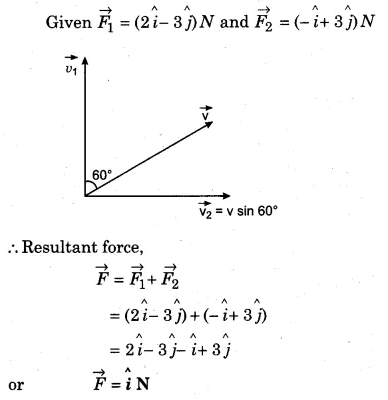
Question 12.
One of the two perpendicular components of velocity (10 m/s) of a particle makes an angle of 60° with the intended velocity. Then, find out the another component of velocity.
Solution:
Given v1 = 10 ms-1
According to the figure the other component of intended velocity,
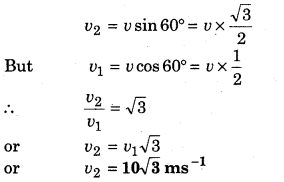
Question 13.
If an experiences a force of \(\vec{F}=(\hat{i}+\hat{j}-2 \hat{k}) N\) and displacement, \(d \vec{r}=(-\hat{i}+2 \hat{j}-\hat{k}) m\). Then, determine the work and the angle between \(\overrightarrow{\boldsymbol{F}}\) and \(d \vec{r}\).
Solution:
Given; \(\vec{F}=(\hat{i}+\hat{j}-2 \hat{k}) N\) and
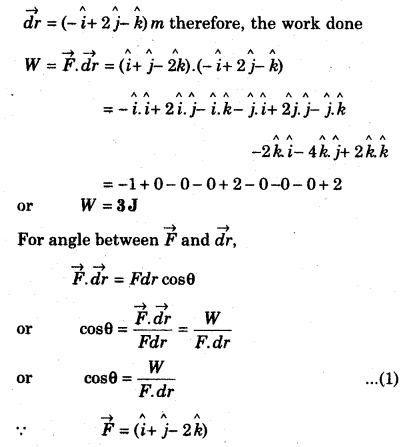
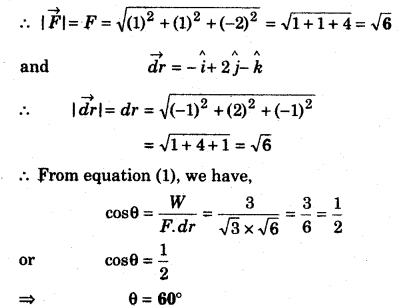
Question 14.
If an electron moves with a velocity, \(\overrightarrow{\boldsymbol{v}}=(2 \hat{\mathbf{i}}-3 \hat{\boldsymbol{j}}+\hat{\boldsymbol{k}})\) m/s in a magnetic field, \(\vec{B}=(2 \hat{i}+\hat{j}-\hat{k}) T\). Then, calculate the Lorentz force.
Solution:
The value of lorentz force
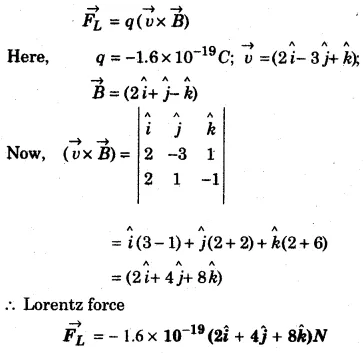
Question 15.
The potential energy of a particle is U = y2 siny. The force defined on this particle is F = \(-\frac{d U}{d y}\). Calculate the force
Solution:
Given; U = y2 sin y and F = \(-\frac{d U}{d y}\), F = ?
∴ F = \(-\frac{d U}{d y}=-\frac{d}{d y}\left(y^{2} \sin y\right)\)
or F = – (2ysiny + y2 cosy)
Question 16.
The angular momentum and torque of a particle are related to each other as :
\(\vec{\tau}=\frac{d \vec{J}}{d t}\)
If \(\vec{\tau}=\left(t \hat{i}+t^{2} \hat{j}+t^{3} \hat{k}\right)\) and at instant t = 0, \(\vec{J}=(3 \hat{i}+4 \hat{j}+7 \hat{k})\), then represent \(\vec{\jmath}\) as a function of time.
Solution:
